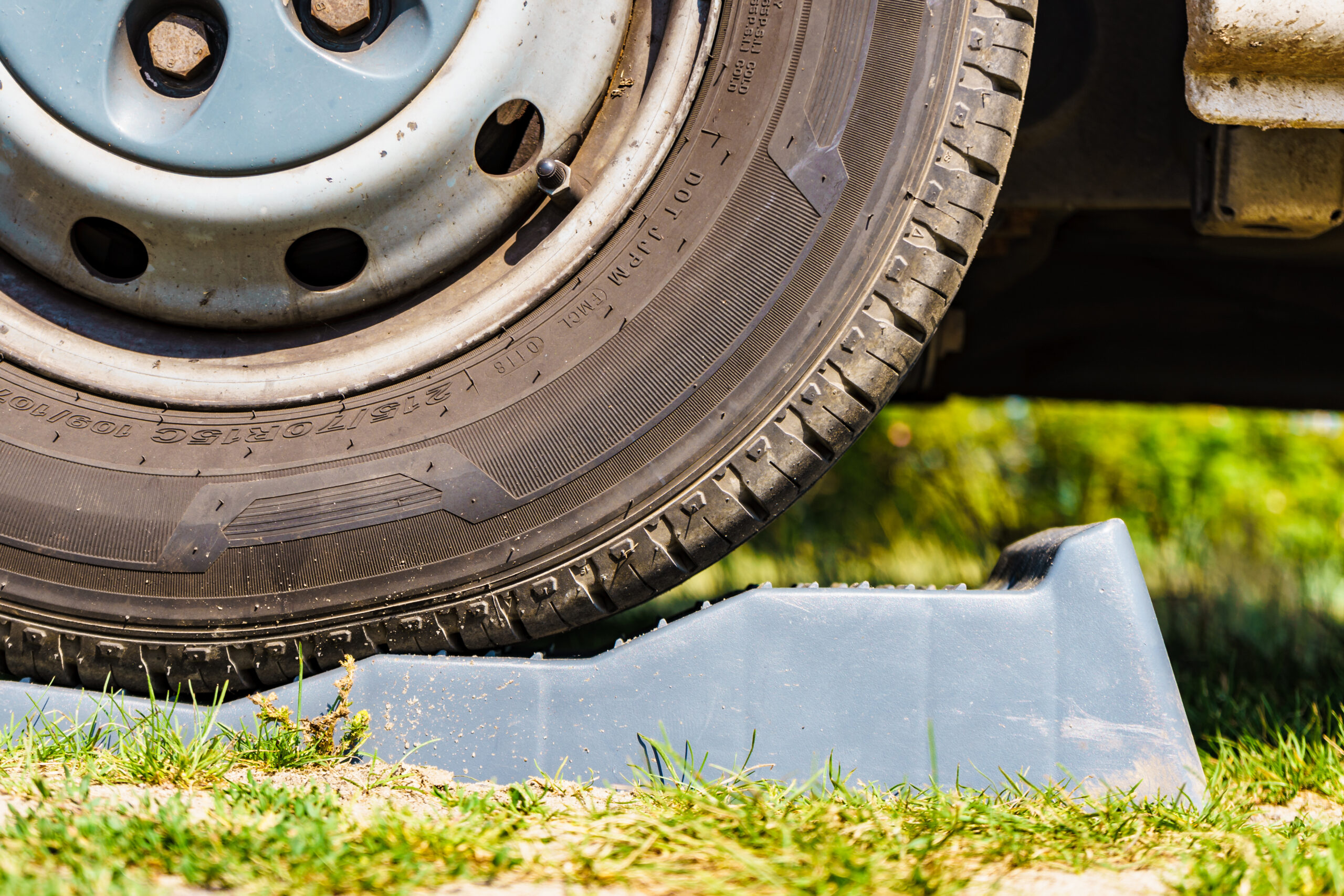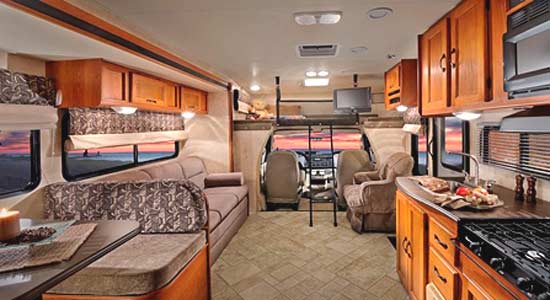Does an RV have to be level?
An RV does not have to be level for you to set up and sleep in it, but for safety and functionality purposes it should be level. One of the most important tasks you need to perform when you arrive at your RV site is, leveling your RV. Having an unlevel RV can cause functionality issues and just make your stay unpleasant from the get-go. When learning how to level an RV you will see it can be done in a few different ways from purchasing blocks and levelers, having auto levelers on your RV, or building homemade leveling blocks for your RV.
Before we show you several ways to make homemade leveling blocks for your RV, let’s talk about why a level RV is important.
How to level an RV: 3 reasons to make sure you are level
1. Take time to relieve the stress
An unlevel RV is adding unnecessary stress to the frame of the RV and over time can bend or even break supporting beams. Traveling to and from your campsite causes enough bending and twisting on your RV already.
If you have slides in your RV this is another reason to assure your RV is leveled the first thing once you begin the setup process. Slides can bind and add stress to moving parts as you extend and retract them.
2. Your refrigerator will thank you
Most refrigerators need to be level in order to work properly, especially when we are using the common Dometic or Norcold type refrigerators. It is recommended that your RV refrigerator not be more than 3 degrees unlevel left to right, or 6 degrees unlevel front to back. An unlevel Dometic fridge means the ammonia cannot move freely in the tubes and blockages may occur.
Most Norcold RV fridges can last years, if not decades. They are known for being durable and reliable, but there are steps to be taken to assure longevity, and leveling the RV is one of them.
3. Lean on me
Leveling your RV will also help improve your camping experience. From sleeping to cooking, everything is easier and more comfortable when your rig is properly leveled. Fortunately, leveling an RV is very easy, so there’s no reason to live in an uncomfortably tilted position.

How to level an RV: Make Your Own DIY RV Leveling Blocks
Now that we have touched on a few of the best reasons for leveling your RV, let’s learn how to get that done. Of course, you can purchase blocks and levelers from your local RV dealer or one of many online websites, but what if I told you there was a cheaper way? Let’s learn several ways to make your own homemade RV leveling blocks and save a few pennies doing it.
DIY leveling blocks are easy to make and you can customize them for your specific RV and needs. Homemade leveling blocks for your RV are usually cheaper than most store-bought versions, but they also tend to be much sturdier. So, let’s tap into your inner crafting skills and see what we can come up with.
DIY Leveling Block Ideas
Not sure where to begin making your own homemade RV leveling blocks? Lucky for you, we have several awesome DIY leveling block ideas. Use one of these ideas below, or treat them as inspiration and create something completely unique.
Each RV and its owner have different needs when it comes to leveling their RV. So, a set of homemade leveling blocks for your RV make perfect sense.
Use planks of wood
One of the cheapest and easiest ways to level your RV is to use planks of wood. Any wood you have on hand will work, but we particularly like pressure-treated 2x8s that can be cut into smaller pieces.
One RVer even added screw eyes and rope to the end of each piece in order to make the blocks easy to place and easy to pick up at the end of each trip.
Rubber pavers
Another easy option is rubber pavers from your local hardware store. These are usually found in the outdoors department. If you can, find some with a pattern that will allow you to cut the pavers in half easily. Once cut in half, these are the perfect length to be used as leveling blocks.
These blocks can be stacked easily and aren’t likely to fall. Because they are a bit thinner than most wood planks, you will be able to make smaller adjustments. Additionally, you can make ramps with this type of block by stacking them on stair steps.
Stackable leveling blocks
If you like to do a lot of boondocking or even just find yourself in campsites that are far from level, you might need something that offers more than 3 inches of correction. No worries! There are options out there.
We particularly like stackable leveling blocks for these types of situations because they allow you to add height or take it away as needed based on where you’re parked. The DIY stackable leveling blocks made in the video above are incredibly sturdy even when stacked, making them an ideal solution.
DIY Andersen-Style Levelers
The Anderson Leveling System is a ridiculously simple leveling system that utilizes a curves leveler that you drive/backup on to raise your RV tire. It’s almost like having a personal ramp to increase your height. The system comes with two levelers and two-wheel chocks, which work together to raise and secure your tires.
Unlike leveling blocks, the Anderson Levelers will allow you to raise the RV to any height you need, up to the maximum height of the system. Ninety-nine percent of the time, the levelers are sufficient at providing enough height.
Best RV leveling blocks
Of course, you can always skip the do-it-yourself route and purchase a set of RV leveling blocks. These store-bought versions will eat into your budget a little more and have very little room for customization at all. I understand that some people just don’t have the time, tools, and resources to build their own homemade leveling blocks for their RV. Below are some of the better options if you do need to take the store-bought path to be level.
Here are our top picks for the best store-bought RV leveling blocks
- RVMATE Levelers – Easily level your trailer with any increment between 1/2″ and 4″ soon. Determine the height you want to achieve. Put the anti-slip pad before placing the curved leveler. Drive the motorhome onto the leveler and stop at the height you want to achieve. Then add the chock under the leveler.

- Andersen Levelers — These are for trailers and fifth wheels only. They level your rig almost automatically, meaning you won’t be left guessing how many blocks to put under the tires.

- Camco Tri-Leveler — We like that this level is basically a ramp with different levels. This allows you to choose the level you need when you get there. Eliminates the need to guess how many blocks to stack up.

- Tri-Lynx Levelers — These are basic, but we like that they are lightweight and easy to store. Additionally, you can add blocks to the set, meaning you can level yourself out even in the most challenging campsites.

Keep it stable too!
- EPOARTIST Camper Wheel Chock Stabilizer – We spoke a lot about leveling your RV in this post. Something else you want to consider once this is accomplished is to minimize the back-and-forth movement also. Wheel chokes can make a big difference when it comes to movement as you walk around inside.

Conclusion
Well, we have talked about RV levelers and how they are important to both the RV and our camping experience. We also talked about the damage it can cause when your RV is out of level.
Whether you choose store-bought or homemade leveling blocks for your RV it is something that needs to be addressed. Remember this every time you are out at your favorite camping spot.
The Best RV leveling blocks are really the choice that works best for you and your RV. So, you choose how you want to handle this task and enjoy the rest of your time out.
Recent Posts
50 Most asked RV questions and the answers for them
All you need to know about your RV propane tanks
RV Insurance coverage you should know about




